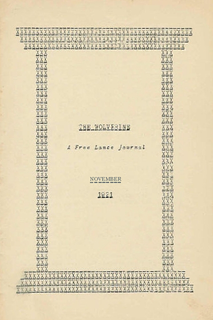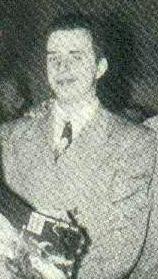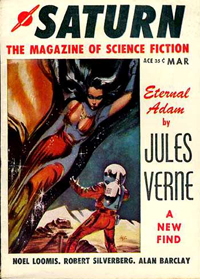
Donald Allen Wollheim was an American science fiction editor, publisher, writer, and fan. As an author, he published under his own name as well as under pseudonyms, including David Grinnell.
Arkham House is an American publishing house specializing in weird fiction. It was founded in Sauk City, Wisconsin in 1939 by August Derleth and Donald Wandrei to preserve in hardcover the best fiction of H. P. Lovecraft. The company's name is derived from Lovecraft's fictional New England city, Arkham. Arkham House editions are noted for the quality of their printing and binding. The colophon for Arkham House was designed by Frank Utpatel.

Weird Tales is an American fantasy and horror fiction pulp magazine founded by J. C. Henneberger and J. M. Lansinger in late 1922. The first issue, dated March 1923, appeared on newsstands February 18. The first editor, Edwin Baird, printed early work by H. P. Lovecraft, Seabury Quinn, and Clark Ashton Smith, all of whom went on to be popular writers, but within a year, the magazine was in financial trouble. Henneberger sold his interest in the publisher, Rural Publishing Corporation, to Lansinger, and refinanced Weird Tales, with Farnsworth Wright as the new editor. The first issue under Wright's control was dated November 1924. The magazine was more successful under Wright, and despite occasional financial setbacks, it prospered over the next 15 years. Under Wright's control, the magazine lived up to its subtitle, "The Unique Magazine", and published a wide range of unusual fiction.

Weird fiction is a subgenre of speculative fiction originating in the late 19th and early 20th centuries. Weird fiction either eschews or radically reinterprets ghosts, vampires, werewolves, and other traditional antagonists of supernatural horror fiction. Writers on the subject of weird fiction, such as China Miéville, sometimes use "the tentacle" to represent this type of writing. The tentacle is a limb-type absent from most of the monsters of European folklore and gothic fiction, but often attached to the monstrous creatures created by weird fiction writers, such as William Hope Hodgson, M. R. James, and H. P. Lovecraft. Weird fiction often attempts to inspire awe as well as fear in response to its fictional creations, causing commentators like Miéville to paraphrase Goethe in saying that weird fiction evokes a sense of the numinous. Although "weird fiction" has been chiefly used as a historical description for works through the 1930s, it experienced a resurgence in the 1980s and 1990s, under the labels of New Weird and Slipstream, which continues into the 21st century.

Unknown was an American pulp fantasy fiction magazine, published from 1939 to 1943 by Street & Smith, and edited by John W. Campbell. Unknown was a companion to Street & Smith's science fiction pulp, Astounding Science Fiction, which was also edited by Campbell at the time; many authors and illustrators contributed to both magazines. The leading fantasy magazine in the 1930s was Weird Tales, which focused on shock and horror. Campbell wanted to publish a fantasy magazine with more finesse and humor than Weird Tales, and put his plans into action when Eric Frank Russell sent him the manuscript of his novel Sinister Barrier, about aliens who own the human race. Unknown's first issue appeared in March 1939; in addition to Sinister Barrier, it included H. L. Gold's "Trouble With Water", a humorous fantasy about a New Yorker who meets a water gnome. Gold's story was the first of many in Unknown to combine commonplace reality with the fantastic.

"The Nameless City" is a short horror story written by American writer H. P. Lovecraft in January 1921 and first published in the November 1921 issue of the amateur press journal The Wolverine. It is often considered the first story set in the Cthulhu Mythos world. In the story, the protagonist travels to the middle of the Arabian Desert to explore an ancient underground city.

Robert Augustine Ward "Doc" Lowndes was an American science fiction author, editor and fan. He was known best as the editor of Future Science Fiction, Science Fiction, and Science Fiction Quarterly, among many other crime-fiction, western, sports-fiction, and other pulp and digest sized magazines for Columbia Publications. Among the most famous writers he was first to publish at Columbia was mystery writer Edward D. Hoch, who in turn would contribute to Lowndes's fiction magazines as long as he was editing them. Lowndes was a principal member of the Futurians. His first story, "The Outpost at Altark" for Super Science in 1940, was written in collaboration with fellow Futurian Donald A. Wollheim, uncredited.

Saturn was an American magazine published from 1957 to 1965. It was launched as a science fiction magazine, but sales were weak, and after five issues the publisher, Robert C. Sproul, switched the magazine to hardboiled detective fiction that emphasized sex and sadism. Sproul retitled the magazine Saturn Web Detective Story Magazine to support the change, and shortened the title to Web Detective Stories the following year. In 1962, the title was changed yet again, this time to Web Terror Stories, and the contents became mostly weird menace tales—a genre in which apparently supernatural powers are revealed to have a logical explanation at the end of the story.
Uncanny Tales was a Canadian science fiction pulp magazine edited by Melvin R. Colby that ran from November 1940 to September 1943. It was created in response to the wartime reduction of imports on British and American science-fiction pulp magazines. Initially it contained stories only from Canadian authors, with much of its contents supplied by Thomas P. Kelley, but within a few issues Colby began to obtain reprint rights to American stories from Donald A. Wollheim and Sam Moskowitz. Paper shortages eventually forced the magazine to shut down, and it is now extremely rare.
William Levi Crawford was an American publisher and editor.

Science Fiction Quarterly was an American pulp science fiction magazine that was published from 1940 to 1943 and again from 1951 to 1958. Charles Hornig served as editor for the first two issues; Robert A. W. Lowndes edited the remainder. Science Fiction Quarterly was launched by publisher Louis Silberkleit during a boom in science fiction magazines at the end of the 1930s. Silberkleit launched two other science fiction titles at about the same time: all three ceased publication before the end of World War II, falling prey to slow sales and paper shortages. In 1950 and 1951, as the market improved, Silberkleit relaunched Future Fiction and Science Fiction Quarterly. By the time Science Fiction Quarterly ceased publication in 1958, it was the last surviving science fiction pulp magazine, all other survivors having changed to different formats.

Science-Fiction Plus was an American science fiction magazine published by Hugo Gernsback for seven issues in 1953. In 1926, Gernsback had launched Amazing Stories, the first science fiction magazine, but he had not been involved in the genre since 1936, when he sold Wonder Stories. Science-Fiction Plus was initially in slick format, meaning that it was large-size and printed on glossy paper. Gernsback had always believed in the educational power of science fiction, and he continued to advocate his views in the new magazine's editorials. The managing editor, Sam Moskowitz, had been a reader of the early pulp magazines, and published many writers who had been popular before World War II, such as Raymond Z. Gallun, Eando Binder, and Harry Bates. Combined with Gernsback's earnest editorials, the use of these early writers gave the magazine an anachronistic feel.

Avon published three related magazines in the late 1940s and early 1950s, titled Avon Fantasy Reader, Avon Science Fiction Reader, and Avon Science Fiction and Fantasy Reader. These were digest size magazines which reprinted science fiction and fantasy literature by now well-known authors. They were edited by Donald A. Wollheim and published by Avon.

Cosmic Stories and Stirring Science Stories were two American pulp science fiction magazines that published a total of seven issues in 1941 and 1942. Both Cosmic and Stirring were edited by Donald A. Wollheim and launched by the same publisher, appearing in alternate months. Wollheim had no budget at all for fiction, so he solicited stories from his friends among the Futurians, a group of young science fiction fans including James Blish and C. M. Kornbluth. Isaac Asimov contributed a story, but later insisted on payment after hearing that F. Orlin Tremaine, the editor of the competing science fiction magazine Comet, was irate at the idea of a magazine that might "siphon readership from magazines that paid", and thought that authors who contributed should be blacklisted. Kornbluth was the most prolific contributor, under several pseudonyms; one of his stories, "Thirteen O'Clock", published under the pseudonym "Cecil Corwin", was very successful, and helped to make his reputation in the field. The magazines ceased publication in late 1941, but Wollheim was able to find a publisher for one further issue of Stirring Science Stories in March 1942 before war restrictions forced it to close again.

Miracle Science and Fantasy Stories was an American pulp science fiction magazine which published two issues in 1931. The fiction was unremarkable, but the cover art and illustrations, by Elliott Dold, were high quality, and have made the magazine a collector's item. The magazine ceased publication when Dold became ill and was unable to continue his duties both as editor and artist.

Out of This World Adventures was an American pulp magazine which published two issues, in July and December 1950. It included several pages of comics as well as science fiction stories. It was edited by Donald A. Wollheim and published by Avon. Sales were weak, and after two issues Avon decided to cancel it.

Strange Tales was an American pulp magazine first published from 1931 to 1933 by Clayton Publications. It specialized in fantasy and weird fiction, and was a significant competitor to Weird Tales, the leading magazine in the field. Its published stories include "Wolves of Darkness" by Jack Williamson, as well as work by Robert E. Howard and Clark Ashton Smith. The magazine ceased publication when Clayton entered bankruptcy. It was temporarily revived by Wildside Press, which published three issues edited by Robert M. Price from 2003 to 2007.

Tales of Magic and Mystery was a pulp magazine which published five monthly issues from December 1927 to April 1928. It was edited by Walter Gibson, and published a mixture of fiction and articles on magic. It is now mainly remembered for having published a story by H.P. Lovecraft.

10 Story Fantasy was a science fiction and fantasy pulp magazine which was launched in 1951. The market for pulp magazines was already declining by that time, and the magazine only lasted a single issue. The stories were of generally good quality, and included work by many well-known writers, such as John Wyndham, A.E. van Vogt and Fritz Leiber. The most famous story it published was Arthur C. Clarke's "Sentinel from Eternity", which later became part of the basis of the movie 2001: A Space Odyssey.

Science-fiction and fantasy magazines began to be published in the United States in the 1920s. Stories with science-fiction themes had been appearing for decades in pulp magazines such as Argosy, but there were no magazines that specialized in a single genre until 1915, when Street & Smith, one of the major pulp publishers, brought out Detective Story Magazine. The first magazine to focus solely on fantasy and horror was Weird Tales, which was launched in 1923, and established itself as the leading weird fiction magazine over the next two decades; writers such as H.P. Lovecraft, Clark Ashton Smith and Robert E. Howard became regular contributors. In 1926 Weird Tales was joined by Amazing Stories, published by Hugo Gernsback; Amazing printed only science fiction, and no fantasy. Gernsback included a letter column in Amazing Stories, and this led to the creation of organized science-fiction fandom, as fans contacted each other using the addresses published with the letters. Gernsback wanted the fiction he printed to be scientifically accurate, and educational, as well as entertaining, but found it difficult to obtain stories that met his goals; he printed "The Moon Pool" by Abraham Merritt in 1927, despite it being completely unscientific. Gernsback lost control of Amazing Stories in 1929, but quickly started several new magazines. Wonder Stories, one of Gernsback's titles, was edited by David Lasser, who worked to improve the quality of the fiction he received. Another early competitor was Astounding Stories of Super-Science, which appeared in 1930, edited by Harry Bates, but Bates printed only the most basic adventure stories with minimal scientific content, and little of the material from his era is now remembered.

















